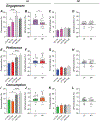Engagement for alcohol escalates in the 5-choice serial reaction time task after intermittent access
- PMID: 38286210
- PMCID: PMC11278111
- DOI: 10.1016/j.alcohol.2024.01.004
Engagement for alcohol escalates in the 5-choice serial reaction time task after intermittent access
Abstract
Excessive intake plays a significant role in the development of alcohol use disorder and impacts 15 million Americans annually, with approximately 88 000 dying from alcohol related deaths. Several facets we contribute to alcohol use disorder include impulsivity, motivation, and attention. Previous studies have used the 5-Choice Serial Reaction Time Task (5-Choice) to analyze these types of behaviors using sugar, but recently we have published using 10% alcohol as the reward. This study analyzed 48 mice that were trained to respond for alcohol in the 5-Choice. All mice distributed and analyzed first by alcohol preference and then by consumption. Here, we became interested in a new classification called "engagement". High-engaged and low-engaged mice were determined by the number of correct responses during final Late-Stage training sessions. Interestingly, during Early-Stage training, the mice began to separate themselves into two groups based on their interaction with the task. Throughout both training stages, high-engaged mice displayed a greater number of trials and correct responses, as well as a lower percentage of omissions compared to low-engaged mice. Following three weeks of intermittent access homecage drinking, low-engaged mice showed greater increase in perseverative responding relative to high-engaged. Additionally, low-engaged mice decreased their reward and correct latencies compared to high-engaged mice suggesting an increase in motivation for alcohol. Overall, engagement analysis presents two clearly different groups, with only one being motivated to work for alcohol. These two distinct phenotypes in the 5-Choice could be used to model alcohol motivated behavior, which could help us further understand alcohol use disorder.
Keywords: 5-Choice, 5-choice serial reaction time task; HE, high-engagement; LE, low-engagement.
Copyright © 2024 Elsevier Inc. All rights reserved.
Conflict of interest statement
Declaration of competing interest The authors declare that the research was conducted in the absence of any commercial or financial relationships that could be construed as a potential conflict of interest.
Figures





Update of
-
Engagement for Alcohol Escalates in the 5-Choice Serial Reaction Time Task After Intermittent Access.bioRxiv [Preprint]. 2023 Dec 1:2023.11.30.569396. doi: 10.1101/2023.11.30.569396. bioRxiv. 2023. Update in: Alcohol. 2024 Mar;115:79-92. doi: 10.1016/j.alcohol.2024.01.004. PMID: 38077076 Free PMC article. Updated. Preprint.
Similar articles
-
Engagement for Alcohol Escalates in the 5-Choice Serial Reaction Time Task After Intermittent Access.bioRxiv [Preprint]. 2023 Dec 1:2023.11.30.569396. doi: 10.1101/2023.11.30.569396. bioRxiv. 2023. Update in: Alcohol. 2024 Mar;115:79-92. doi: 10.1016/j.alcohol.2024.01.004. PMID: 38077076 Free PMC article. Updated. Preprint.
-
Adaptation of the 5-choice serial reaction time task to measure engagement and motivation for alcohol in mice.Front Behav Neurosci. 2022 Sep 16;16:968359. doi: 10.3389/fnbeh.2022.968359. eCollection 2022. Front Behav Neurosci. 2022. PMID: 36187376 Free PMC article.
-
Excessive alcohol consumption after exposure to two types of chronic social stress: intermittent episodes vs. continuous exposure in C57BL/6J mice with a history of drinking.Psychopharmacology (Berl). 2022 Oct;239(10):3287-3296. doi: 10.1007/s00213-022-06211-8. Epub 2022 Aug 16. Psychopharmacology (Berl). 2022. PMID: 35974246
-
Genes and Alcohol Consumption: Studies with Mutant Mice.Int Rev Neurobiol. 2016;126:293-355. doi: 10.1016/bs.irn.2016.02.014. Int Rev Neurobiol. 2016. PMID: 27055617 Free PMC article. Review.
-
Intermittent ethanol access schedule in rats as a preclinical model of alcohol abuse.Alcohol. 2014 May;48(3):243-52. doi: 10.1016/j.alcohol.2014.01.006. Epub 2014 Mar 15. Alcohol. 2014. PMID: 24721195 Free PMC article. Review.
Cited by
-
Sex and Genetic Differences in Behavioral Engagement of Crossed High Alcohol-Preferring and Low Alcohol-Preferring Mice.Genes Brain Behav. 2025 Jun;24(3):e70026. doi: 10.1111/gbb.70026. Genes Brain Behav. 2025. PMID: 40492535 Free PMC article.
References
-
- CDC. Excessive Drinking Costs U.S. $223.5 Billion, Center for Disease Control: Atlanta, GA: 2014.
-
- Dawson DA, Grant BF, Li TK Quantifying the risks associated with exceeding recommended drinking limits, Alcohol Clin Exp Res 2005: 29: 902–908. - PubMed
MeSH terms
Substances
Grants and funding
LinkOut - more resources
Full Text Sources
Medical

